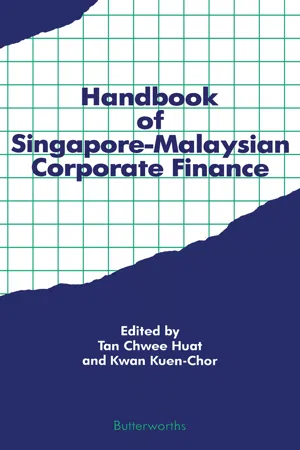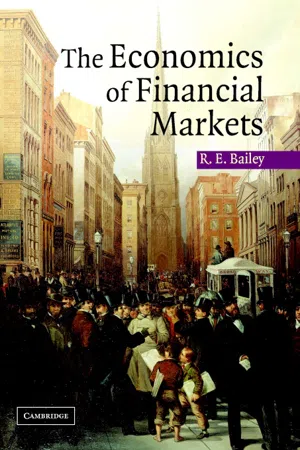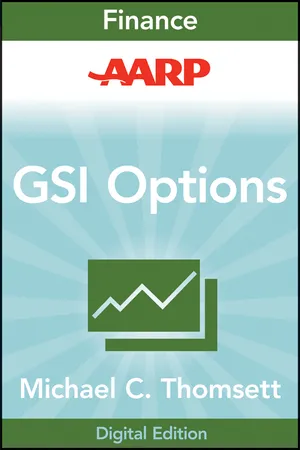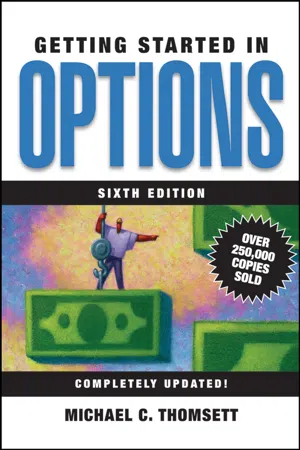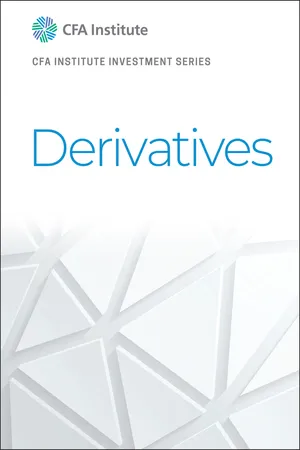Economics
Call and Put Options
Call and put options are financial contracts that give the holder the right, but not the obligation, to buy (call option) or sell (put option) a specific asset at a predetermined price within a set time frame. Call options are typically used by investors who anticipate an asset's price to rise, while put options are used by those expecting the price to fall.
Written by Perlego with AI-assistance
Related key terms
1 of 5
6 Key excerpts on "Call and Put Options"
- Tan Chwee Huat, Kwan Kuen-Chor, Tan Chwee Huat, Kwan Kuen-Chor(Authors)
- 2014(Publication Date)
- Butterworth-Heinemann(Publisher)
With the rapid growth of Singapore as a financial centre, we can expect interest in option instruments to grow further to be in line with the other major markets in the world. 18.02 Put and Call Options An option is a legally binding agreement between a buyer and a seller to purchase or to sell a particular asset at a specified price on or before a spe-cific time period. There are several types of asset on which options can be written, such as c o m m o n shares (for example, shares in IBM, General Motors and Boeing), commodities (for example, gold and silver), financial futures (for example, Eurodollars) and currencies (for example, Sterling pound, Japanese yen and Deutschmark). Let us now formally define the two types of option, namely, a call option and a put option. A call option gives the holder (or option buyer) the right, but not the obligation, to purchase the underlying commodity. The call writer (or the option seller) is obligated to sell the particular com-modity upon the holder's demand and in accordance with previously agreed conditions. Similarly, a put option gives the holder the right, but not the obligation, to sell the underlying commodity. The put writer is obligated to buy the particular commodity upon the holder's demand and in accordance with the previously agreed conditions. The best way to remember the difference between a call and a put option is to relate the implications of the terms 'call' and 'put' with the contractual rights of the option holder. The call option holder buys the right to purchase the commodity underlying the call option. The right to purchase is implied by the term 'call'. On the other hand, the put option buyer buys the right to sell the commodity underlying the put option. Again, the right to sell is implied by the term 'put'. Often, one will hear of a call option holder 'calling' the underlying commodity from the writer; or, conversely, of the put option holder 'putting' the underlying commodity to the writer.- eBook - PDF
- Roy E. Bailey(Author)
- 2005(Publication Date)
- Cambridge University Press(Publisher)
18 Options markets I: fundamentals Overview An option contract provides its owner with the discretion to buy or to sell an underlying asset. A call option confers the discretion to buy the asset, while a put option confers the discretion to sell. Unlike futures contracts, where the owner must either offset the contract or make delivery at maturity, the owner of an option can simply let the contract expire; that is, the option can be thrown away. This is the crucial distinction between futures and options. Options form a subset of a broader class of ‘contingent claims’ contracts – financial instruments the payoffs on which depend upon the payoffs of some other underlying asset. Thus, for stock options the option to buy or sell a unit of a company’s equity depends, among other things, on the market value of the shares. Options are, perhaps, the most commonly encountered sort of contingent claim, but, as shown in chapter 19, the basic ideas can be applied more generally. This chapter is the first of three that explore option contracts and the markets in which they are traded. Chapter 19 studies option price determination, while chap-ter 20 applies the principles to a variety of contracts found in financial markets. Section 18.1 defines Call and Put Options, outlines their main properties and introduces some notation. The most commonly studied option contracts are options to buy or sell the ordinary shares of a publicly traded company – i.e. equity options. It should be assumed that these are the contracts being analysed unless stated otherwise. Section 18.2 outlines the many other sorts of option contracts that are traded in financial markets. In addition, some financial assets that do not appear to be options have option-like features. A brief commentary on these forms the subject of section 18.3. - eBook - PDF
Basic Finance
An Introduction to Financial Institutions, Investments, and Management
- Herbert Mayo, , , (Authors)
- 2018(Publication Date)
- Cengage Learning EMEA(Publisher)
Any time premium that the options commanded prior to expiration must disappear, since the option can be worth only its intrinsic value. If the option is out of the money, the option has no value and expires. Puts and calls are created and sold by investors (writers) who are either naked or covered. Covered call writing occurs when the individual owns the underlying stock. If the individual does not own the stock and writes a call (is a naked writer), the in-dividual is exposed to substantial risk if the price of the stock rises. In addition to options on individual stocks, put and call options exist on indexes of stock prices. Stock index options permit individuals to take long and short posi-tions on the market without having to select individual stocks. These investors avoid the risk associated with individual securities. Options also exist on bonds and for-eign exchange, which grant individuals the right to buy and sell these assets instead of actually buying and selling the bonds or currencies. Summary Review Objectives Now that you have completed this chapter, you should be able to 1. Describe the features of put and call options (p. 501). 2. Differentiate an option’s market value, intrinsic value, and time premium (pp. 501–503). 3. Explain how options offer leverage (pp. 503–507). 4. Explain the relationship between the market price of a stock and the prices of put and call options (pp. 503–507 and 509–511). 5. Compare buying a stock and a call option (pp. 505–507). 6. Contrast naked and covered call option writing (pp. 507–509). 7. Identify the advantages associated with stock index options (pp. 511–512). No actual securities or ETFs are based on the VIX, but the CBOE has created VIX put and call options. These derivatives permit individuals and portfolio man-agers to take positions based on expected volatility. For example, anticipation of increased volatility argues for buying calls or selling puts. - eBook - ePub
- Michael C. Thomsett(Author)
- 2011(Publication Date)
- Wiley(Publisher)
call, which grants its owner the right to buy 100 shares of stock in a company. When you buy a call, it is as though the seller is saying to you, “I will allow you to buy 100 shares of this company’s stock, at a specified price, at any time between now and a specified date in the future. For that privilege, I expect you to pay me the current call’s price.”Each option’s value changes according to changes in the price of the stock. If the stock’s value rises, the value of the call option will follow suit and rise as well. And if the stock’s market price falls, the call option will react in the same manner. When an investor buys a call and the stock’s market value rises after the purchase, the investor profits because the call becomes more valuable. The value of an option actually is quite predictable—it is affected by the passage of time as well as by the ever-changing value of the stock.Smart Investor TipChanges in the stock’s value affect the value of the option directly, because while the stock’s market price changes, the option’s specified price per share remains the same. The changes in value are predictable; option valuation is no mystery.putan option acquired by a buyer or granted by a seller to sell 100 shares of stock at a fixed price within a specified time period.The second type of option is the put . This is the opposite of a call in the sense that it grants a selling right instead of a purchasing right. The owner of a put contract has the right to sell 100 shares of stock. When you buy a put, it is as though the seller were saying to you, “I will allow you to sell me 100 shares of a specific company’s stock, at a specified price per share, at any time between now and a specific date in the future. For that privilege, I expect you to pay me the current put’s price.”The attributes of calls and puts can be clarified by remembering that either option can be bought or sold. This means there are four possible permutations to option transactions:1. Buy a call (buy the right to buy 100 shares). 2. Sell a call (sell to someone else the right to buy 100 shares from you). 3. Buy a put (buy the right to sell 100 shares). 4. Sell a put (sell to someone else the right to sell 100 shares to you). - eBook - PDF
- Michael C. Thomsett(Author)
- 2005(Publication Date)
- Wiley(Publisher)
Pending expiration reduces the likelihood of out-of-the- money options being exercised, and distance between market price of the stock 42 OPENING, CLOSING, TRACKING: HOW IT ALL WORKS and striking price of the call means the seller’s profits are more likely to materi- alize than are the hopes of the buyer. 3. Type of option. Understanding the distinction between calls and puts is essential to success in the options market; the two are opposites. Identical strategies cannot be used for calls and puts, for reasons beyond the obvious fact that they react to stock price movement differently. Calls are by definition the right to buy 100 shares, whereas puts are the right to sell 100 shares. But merely comprehending the essential opposite nature of the two contracts is not enough. It might seem at first glance that, given the behavior of calls and puts when in the money or out of the money, it would make no difference whether you buy a put or sell a call. As long as expiration and striking price are identical, what is the difference? In practice, however, significant differ- ences do make these two ideas vastly different in terms of risk. When you buy a put, your risk is limited to the amount you pay for premium. When you sell a call, your risk can be far greater because the stock may rise many points, re- quiring the call seller to deliver 100 shares at a price far below current market value. Each specific strategy has to be reviewed in terms not only of likely price movement given a set of market price changes in the underlying stock, but also how one’s position is affected by exposure to varying degrees of risk. Some of the more exotic strategies involving the use of calls and puts at the same time, or buying and selling of the same option with different striking prices, are examples of advanced techniques, which will be explored in detail in later chapters. 4. Underlying stock. Every option is identified with a specific company’s stock, and this cannot be changed. - eBook - PDF
- (Author)
- 2021(Publication Date)
- Wiley(Publisher)
In fact, by selling a covered call while purchasing a protective put, the investor establishes a combined position with fixed downside protection while still providing some opportunity for profits. Now consider an investor who has a bullish view. Buying calls is an option strategy that will allow the investor to benefit if her outlook is correct and implied volatility increases. When implied volatilities are expected to fall, writing a put represents an alternative strategy to take advantage of a bullish market view with declining volatility. If this happens, the position will likely be profitable, because as the stock rises and implied volatility decreases, the short put moves farther out of the money and its price will decrease. The combined position in which the investor is long calls and short puts (i.e., a long risk reversal) is used to implement a bullish view (the investor buys the calls) while lowering the cost (the investor sells the puts) of the long position in the underlying asset that will be established upon exercising the options. Investors can also decide to sell puts when they want to buy a stock only if the price declines below a determined target price (the strike price of the puts will be the same as this target price). In this case, by selling the put options when implied volatilities are elevated (and the puts are expensive), the investor can realize an effective stock purchase price that is less than the target (strike) price by the size of the premium received. The purchase of call or put spreads tends to be most appropriate when the investor has a bullish view (call bull spread) or a bearish view (put bear spread) but the underlying market is not clearly trending upward or downward. Furthermore, such spreads are a way to reduce the total cost, given that the spread is normally constructed by buying one option and writing another.
Index pages curate the most relevant extracts from our library of academic textbooks. They’ve been created using an in-house natural language model (NLM), each adding context and meaning to key research topics.
